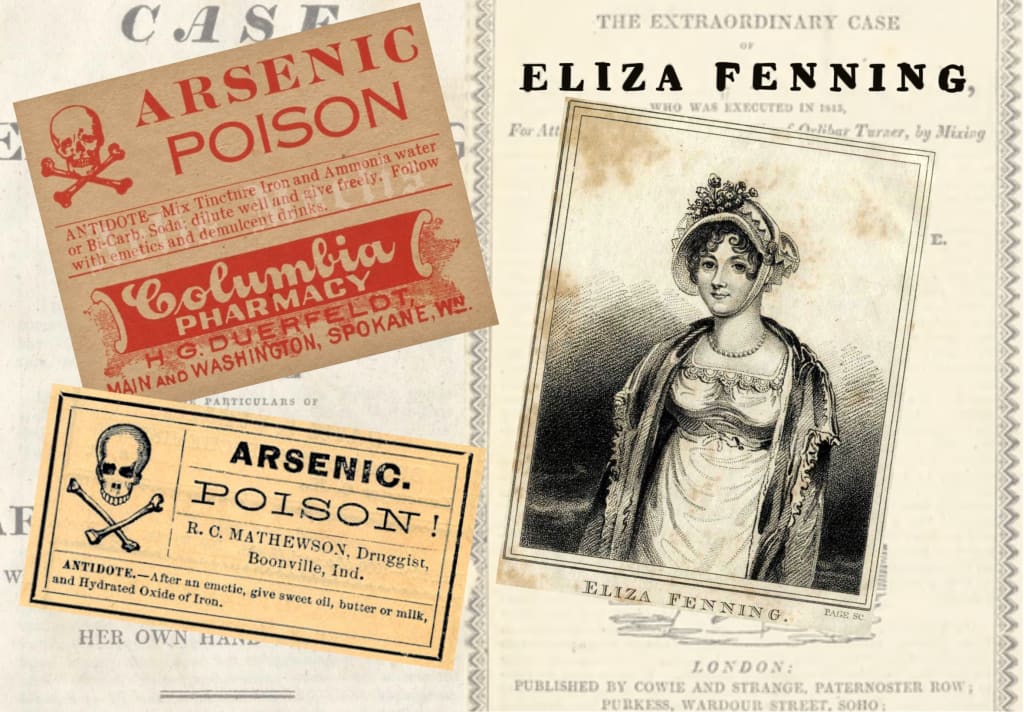The Girl Whose Horrific Cooking Resulted in Her Early Death
Eliza Fenning guilty or innocent?

Eliza Fenning was a name that would have disappeared into obscurity had it not been for the employment she decided to take in January 1815. Eliza, believed to be in her early 20s, took the position of domestic servant to law stationer Robert Turner.
The job at Chancery Lane would involve a range of tasks, including working in the kitchen and helping to prepare and cook meals for the family. This cooking wrote her into the history books and made her a controversial figure.
A delicious lunch
On 21st March 1918, the Turner family sat down to lunch. Eliza had been working for the family for seven weeks at this point. The lunch party consisted of Robert Turner, his wife Charlotte and Robert's law partner, Haldebart Turner.
Lunch consisted of steak, with potatoes and dumplings. Eliza helped make the dumplings and then served the food to the family. Unfortunately, not long after this, all three guests started having severe stomach pains and vomiting.
As well as the family becoming ill, one of Turner's apprentices also fell ill after he ate one of the dumplings in the kitchen. Eliza was the fifth person to become sick with the same symptoms.
A Doctor to investigate
It became apparent early on that a doctor was needed, so Robert sent for the local physician. Robert suspected that the family were suffering from arsenic poisoning. He had noticed a packet missing from his drawer a few days ago.
Arsenic in the 1800s was a popular poison for killing rats; it was also straightforward to attain, and most houses would have had a supply within their walls.
At the request of Robert after the Doctor had administered to the family, he went to search the kitchen. In the early days of criminology, doctors first investigated these illnesses.
As the Doctor entered the kitchen, he found that the dough which had made the dumplings was blackened. Heating the mixture and then letting it cool revealed white crystals at the bottom, a sign of arsenic.
Arrest and court
Immediately Eliza took responsibility for making the dumplings, stating that she did not believe the arsenic was in the flour as she had made meat pudding the day before and everyone had been fine; instead, she wondered whether it had been in the yeast.
Regardless of her help, Eliza was arrested two days later for the attempted murder of the Turner family. Even though all the evidence towards her was circumstantial and the investigation flawed, in April 1815, Eliza appeared at the Old Bailey charged with attempted murder.
As a witness, Charlotte Turner offered the jury the only motive they needed. It transpired that a couple of days before the poisoning, Charlotte had seen Eliza leaving an apprentice's room in a state of undress. She confronted Eliza about her behaviour, who then thought she would lose her job.
The evidence against Eliza increased when the judge demonstrated that she could read, causing the jury to believe she would have known what she was taking from Robert's drawer. It was, however, not proved that she was the person who removed the packet.
No defence
Legal counsel of the time was in contrast to what we see now. Any legal advice did not support the defendants; it was the defendant's job to represent themselves. Unfortunately, this was a task that Eliza did not do well, taking a stand and giving a short statement.
Four friends were also invited to take the stand and speak about her excellent character and nature. Unfortunately, none of this was enough to persuade the jury, and within minutes they found her guilty of attempted murder. The judge ruled that she was to be hung until dead.
Guilty or not guilty
Newspapers had become popular in England over this period in history, and when they reported the case, it caused a public outcry. Very few people believed that she had been guilty.
Prominent men pleaded to the government to reexamine the evidence and sentence of Elise, one of these being the Prince Regent. However, it was all in vain and on 26th July 1815, Eliza was executed.
However, the claims of her innocence have never died, with Charles Dickens stating opening that he believed her to be innocent. So if not Eliza, then who did poison the Turner family?
Many historians believe that the poisoner was Robert Turner, who may have been trying to kill his wife or business partner. He knew where the poison was; once he told people it had gone missing, it was relatively easy to incriminate his young servant.
Eliza Fenning is a name that has remained in history books, not only because she may have been executed as an innocent woman but due to the changes in political and legal areas that resulted from her case.
Turner's poisoning was one of the cases that led to the introduction of tighter control measures on the sale of arsenic. In 1851, the Arsenic Act 1851 changed the sale altogether, introducing the coloured of it to indigo and tighter controls on the sale of such a potentially hazardous substance.
Originally published at https://www.murdermayhem.uk on February 27, 2023.
About the Creator
Sam H Arnold
Writing stories to help, inspire and shock. For all my current writing projects click here - https://linktr.ee/samharnold






Comments
There are no comments for this story
Be the first to respond and start the conversation.